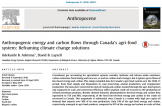Greenhouse gas accounting for agricultural systems consider methane and nitrous oxide emissions, carbon emissions from liming and urea use, as well as carbon stock changes, but it ignores gross flows of bio-based energy and carbon. This study compiled data for Canada's agri-food system over the 2010-13 period, from food supply and disposition to crop processing, animal production, and crop/pasture production. The data were converted to units of energy and carbon, tracked through the agri-food system and compared in scale and conversion efficiency with Canadian crude oil recovery to the production of refined petroleum products. Results showed domestic photosynthesis-derived energy and carbon flow equivalent to 75% and 98%, respectively, of the fossil fuel-derived energy and carbon in the crude oil recovered in Canada. This magnitude is substantial since Canada is a nation with high per capita oil demand that exports over 50% of its own production. Only 14% of the agri-food energy and carbon, respectively, emerged in agri-food products, compared to 91% of the energy and carbon in crude oil that resulted in refined petroleum products. The low conversion efficiency of the agri-food system derived, in part, from 40% of bio-based energy and carbon being diverted to crop and animal residues or waste. Per unit of energy in end products, the other energy inputs (e.g. electricity, fuels) needed to support the agri-food system were 5.3-fold higher in the agri-food system than in the crude oil to products system. This study highlights the need to develop strategies to better utilise the energy and carbon flows of the agri-food system, thereby reducing fossil energy use and greenhouse gas emissions associated with human activities.
Cite this document
How to cite this publication – should be in the following format: Adetona AB and Layzell DB, 2019. Anthropogenic energy and carbon flows through Canada's agri-food system: Reframing climate change solutions, Anthropocene 27 (2019), 100213.

